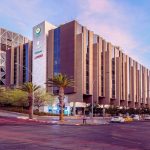Rossing Uranium’s spend on local suppliers amounted to N$2.54 billion during 2022, (compared to N$2.25 billion in 2021), accounting for 74% of our total procurement expenditure, its Managing Director, Johan Coetzee has said.
“As a major employer and purchaser of goods and services, we make a significant annual contribution to economic development in the Erongo Region in particular and to Namibia at large,” he said while presenting the mine’s 2022 Sustainability and Performance Report last week.
He also stated that A highlight for Rossing in 2022 was the commissioning of the mine’s new water reservoirs at a cost of N$100 million.
“These reservoirs provide an additional 60,000 cubic meters of storage capacity, enabling us to continue operating during periods of high sulphur bloom in the Atlantic ocean, resulting in fresh water supply interruptions due to the stoppage of the Orano desalination plant during these periods,” he said.
Rossing’s production in 2022 was lower when compared to 2021. A total of 16.6 million tonnes was mined, compared to 20.7 million tonnes in 2021, with waste and low-grade ore totalling 7.4 million tonnes. The lower mining volume was due to the stripping ratio of waste to ore reducing as we move deeper into the pit. 9.0 million tonnes of ore was milled, compared to: 9.6 million tonnes milled in 2021.
A total of 2 659 metric tonnes uranium oxide was produced, compared to 2,882 metric tonnes in 2021.
Rossing contributed approximately 4.4% to world primary production during 2022, with Namibia now being the 3rd largest primary producer of U308 globally, after Kazakhstan, (who continues to dominate the market from a supply side), and Canada.
“During 2022, Rossing has been operating on an approved LoM plan to 2026, but has now completed a bankable feasibility study for a Life of Mine extension to 2036. This can be achieved with a further pushback of the existing SJ Pit (Phase 4), fully utilising the 15-year mining licence granted by the Ministry of Mines and Energy in 2021. The objective of the LoME Feasibility Study was to evaluate and document the technical, practical, and economic feasibility to extend the LoM beyond 2026 and issue a Feasibility Study Report to inform an investment decision by the Rossing Board of Directors,” added Coetzee.










